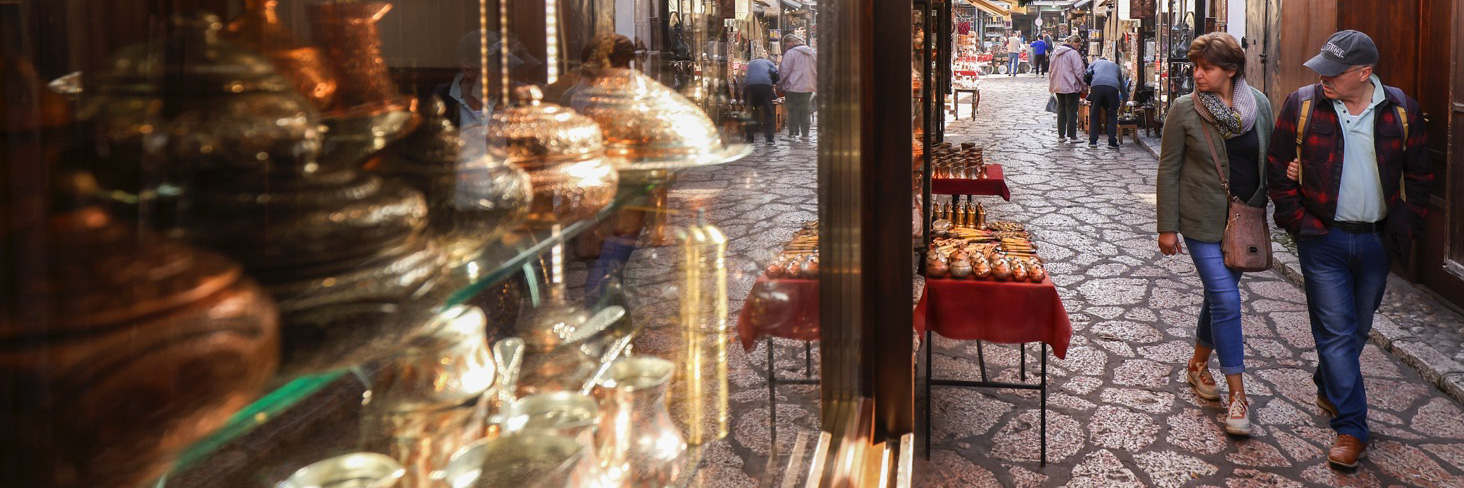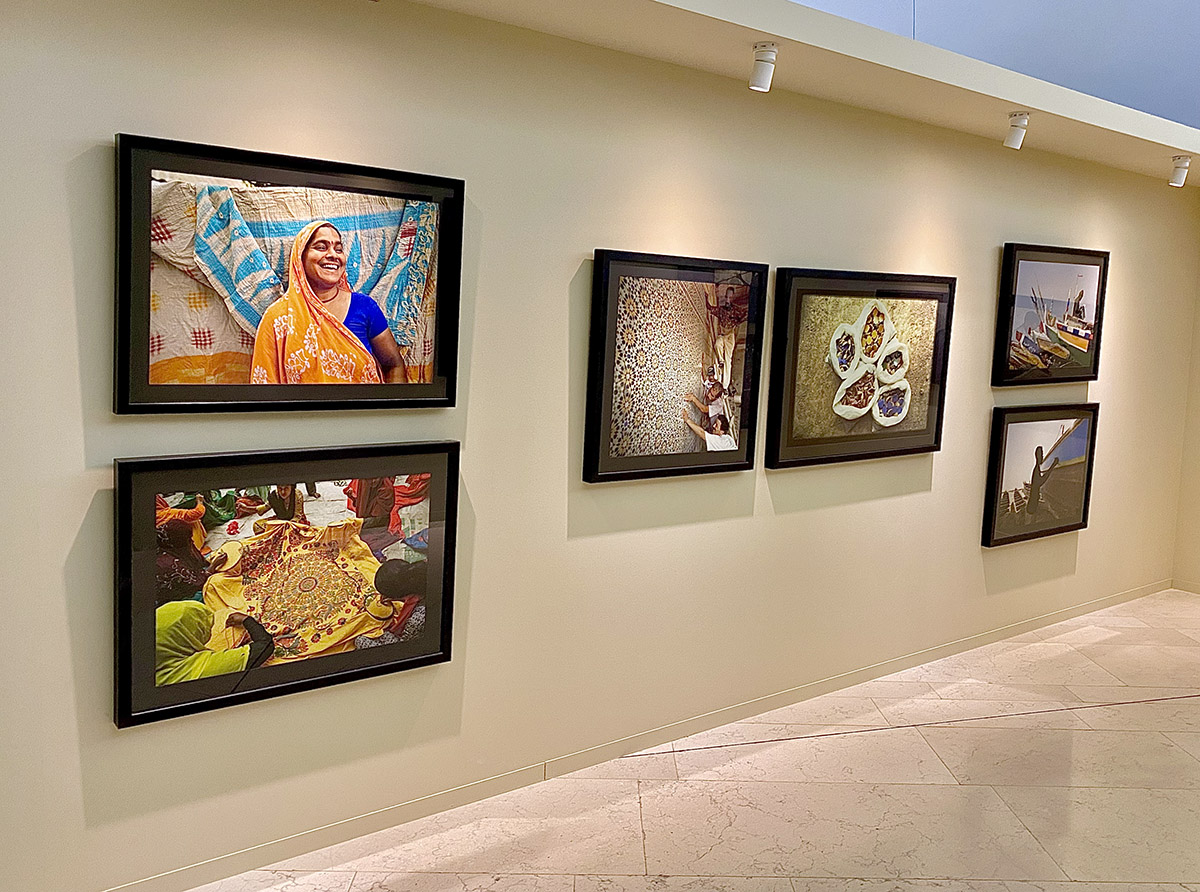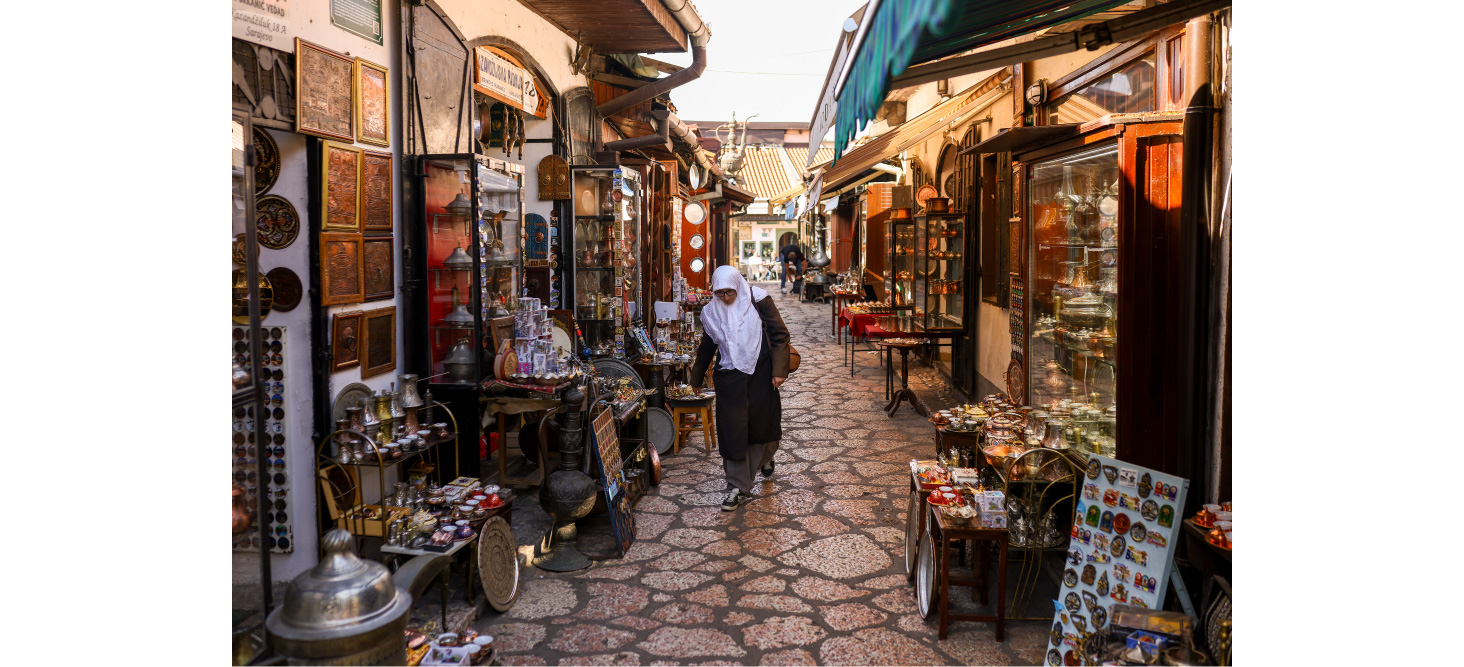
On the resilience of handicrafts in Bosnia-Herzegovina
- Arts
- Crafts
9
By Ian Bancroft / Photography by Armin Durgut

75 Years of Arts & Crafts
The King Abdulaziz Center for World Culture (Ithra), in Saudi Arabia, is hosting the Islamic Art Conference between November 25-30, 2024. As part of the conference, AramcoWorld is presenting an exhibition focused on the publication’s effort to foster positive connections through arts and crafts over the decades. As we celebrate 75 years of AramcoWorld and its numerous stories featuring arts and crafts, this article about Bosnian crafts reflects yet another example of our continuous dedication in this field.

The backstreets of Sarajevo’s old town are alive with the repetitive thud of metalworking. In this European capital, with its contemporary high-rise buildings and modern brands, you can still hear the heartbeat of tradition.
For many here craftsmanship is a family tradition. Eager hands hammer sheets of copper—and even grenades and bullet cartridges left over from the war of the early 1990s—to produce keyrings, plates and other items with decorative or functional value, or both. It is a symphony of ingenuity amid the coffee shops, tearooms, nargileh bars and grilled-meat restaurants whose aromas battle for supremacy.
Local entrepreneurs say the 15th-century arrival of the Ottomans to Bosnia-Herzegovina catalyzed the development of crafts, which dated back to the Illyrians. Cultural exchanges brought new motifs and refined techniques to crafts that included textiles, metal and woodcarvings.
While traditional production has been supplanted in many countries, Bosnia-Herzegovina remains faithful to zanat, meaning “craft” in Bosnian. This dedication is such that another popular craft, woodcarving from Konjic—a small town on the banks of the emerald-green river Neretva, beneath the snowcapped Prenj mountain range, about an hour southwest of Sarajevo—has emerged as one of the country’s signature industries.
The terrain of Bosnia-Herzegovina naturally lends itself to woodcarving. More than 40% of the country is forested, according to official statistics. Historically, the cut trees’ transportation came via the country's magnificent rivers; they rode the ripples to processing plants. Walnut, cherry and maple trees, all ideal for woodcarving, thrive in the Mediterranean climate Konjic and its surroundings enjoy, a climate which allows the wood to dry naturally.
Konjic has entered the global consciousness: In 2017, traditional woodcarving was inscribed on UNESCO’s list of Intangible Heritage of Humanity. Preserving this tradition, however, rests in the hands of a few individuals and families.

Creativity that transcends
Zanat is also the name of the contemporary iteration of a family business that has prospered for four generations. Orhan Nikšić gave up a successful career in international development to pursue a vision that would give “new meaning and life” to the company that specializes in woodcarved furniture through collaborations with well-known designers.
“We offered something extraordinary and different,” he muses, “and our hypothesis was proved right.” The company’s list of designers is formidable, including Japan’s Naoto Fukasawa, renowned for his work with Muji and other leading brands, and award-winning designer Monica Förster.
Konjic’s woodcarving prowess, according to Nikšić, “ensures creative potential.” “When Michele De Lucchi came to our factory, he was like a kid in a candy store,” Nikšić recalls, speaking of the celebrated Italian architect and designer. Each collaborator gets to see firsthand the opportunities afforded by the skills of the woodcarvers. It is not a one-directional process. As Nikšić conveys, “design feeds into the evolution of the craftsmanship [they are] constantly challenged [with] by the designer.”
A dedicated room in Zanat’s award-winning museum displays the names of all Konjic’s woodcarvers. This testament to each individual, no matter where they trained, testifies to the collegiality of the woodcarvers. In less than a decade, Zanat has trained more than 70 young people at its own expense, dramatically cutting the industry’s average age. Some will become collaborators and some competitors. Yet Nikšić believes that this is vital for safeguarding the future of woodcarving.
Zanat’s head woodcarver, Ibrahim Bubalo, nurtures the company’s talents. “Every day you get better and better,” he says modestly, having already reached a level verging on apparent perfection.
Bubalo details how a blank canvas transforms into a work of art. “In the beginning, you draw the lines, then the circles—the roses and the baklava [lozenge shape],” he relays, tracing the lines with his finger. Bubalo, with a chisel in his hand, meticulously forms intricate patterns, giving character and meaning with every movement. Each piece is unique. Any errors are imperceptible to the naked eye.
The Mulić family is another of Konjic’s distinguished woodcarving families. “My mother’s father, my grandfather, opened the firm in 1929,” says owner Sejfudin ‘Sejo’ Vila, adding that “by 1936 he was working for the Vatican, making chairs for the Pope”; they were also used in papal visits to Sarajevo in 1997 and the city of Banja Luka in 2003.
The family’s handicraft adorns mosques, churches (Catholic and Orthodox), hotels and various other places. The value of its collection earned it recognition as a national monument in 2006 by the country's Commission to Preserve National Monuments. As a multireligious country, where cultural connections have thrived for centuries, woodcarving is treasured throughout the country.
“Woodcarving was a status symbol,” Vila attests. “People wanted to live in a better ambiance.” Today, however, Vila sees attitudes changing. “It is like fast food. People want something quick and inexpensive. But if we work artistically, it depends on a golden ratio” of balance and harmony.

Preservation and evolution
The Mulić workshop was where local architect Jasmina Dizdarević discovered woodcarving. She subsequently founded WAGA, an up-and-coming home-décor brand.
“I’ve always been captivated by the tactile sounds of old workshops and the richly carved surfaces that adorned our traditional homes,” Dizdarević says, recalling how “the uniqueness of each stroke and the creation of intricate patterns on flat surfaces mesmerized me as a child.”
Dizdarević’s vision is grounded in the preservation and evolution of woodcarving. “Our approach is different,” Dizdarević insists, adding, "It’s not just about business—this craft should be recognized as art.” She recognizes the “multilayered challenges,” including the economic hurdles. “Reviving the glory that woodcarvers were once known for requires a collective effort,” Dizdarević maintains, involving local authorities and the community.
Ever greater demand for authentic craft globally means that, for Dizdarević, “the future is bright.” However, “there is a struggle to find new apprentices and mentors,” she cautions, offering the example of a family of woodcarvers whose sons went into alternative careers. Though several young apprentices have been educated in Dizdarević’s workshop and a few women carve from home, the town may have to look elsewhere. “Perhaps the future of Konjic woodcarving lies in inviting foreign craftsmen from elsewhere to learn and collaborate with local artisans,” Dizdarević suggests.

Tourists walk along Kazandziluk Street as metalsmith, SakibBaščaušević, works in his more than 100-year-old workshop. Each shopfront is brimming with metal creations–tea sets, coffee pots, trays, mugs, and small souvenir magnets and bookmarks.

For the love of craft
While some have built successful businesses, for others woodcarving is a hobby. Sanjin Bubalo and his brother, both trained by the Nikšić family, use every inch of their garage to produce boxes, backgammon boards and Peškun (a small, round table decorated with carvings). “After the war, this was the only way to make money,” Bubalo reflects.
“We tried to run our own firm,” Bubalo says but the demands of procurement, production, sales, marketing and distribution scuttled their efforts. Today they sell in Sarajevo and Mostar, while Zanat exports more than 90% of what it produces—a dramatic contrast to the past business model.
Illness and death have prematurely ended several of Konjic’s workshops. The industry depends on individuals. And without inheritance, there is no future. “My son is too interested in computers,” Bubalo laughs about whether his 14-year-old is learning the trade.


Sanjin Bubalo poses for a photo with a backgammon board in his small garage/workshop in Konjic, Bosnia.
While the supply of woodcarvers is tenuous, the demand for handicrafts shows no signs of waning. Nikšić sees a “counter-reaction” in an era of automation and mass production. Consumers want “fewer products [but ones] that last,” he prompts. Additionally, a profound element of sustainability fosters universal appeal. Woodcarvers are, by definition, “more in touch with the materials that they use,” Nikšić says.
A handicraft’s provenance is an inevitable question in our mechanized age, the equivalent of university recruiters examining prospective students’ essays for signs of artificial intelligence. For Nikšić, an item’s “imperfectly perfect” nature is proof of the human hand. Minor instances of an unclear cut or out-of-place carve establish it as art.
The age of technical progress and commodification was supposed to confine certain traditional crafts to the dustbin of history. Bosnia-Herzegovina, however, continues to defy the odds, tearing up the pre-written obituaries. Instead, the traditions of the past inspire the present.

About the Author

Armin Durgut
Armin Durgut is a freelance photojournalist and a documentary photographer. He is a regular contributor to Associated Press news agency and other publications. His book and an exhibition, “Mrtvare,” poignantly documents the footwear of the Srebrenica genocide victims, and his work often highlights significant historical and social issues.
Ian Bancroft
Ian Bancroft is a writer and former diplomat based in the former Yugoslavia. He is the author of a novel, Luka, and a work of nonfiction, Dragon’s Teeth: Tales From North Kosovo.